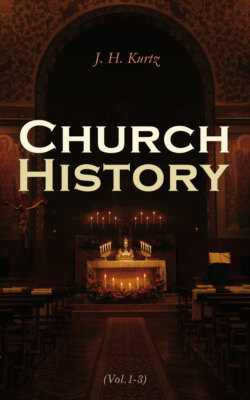Читать книгу Church History (Vol.1-3) - J. H. Kurtz - Страница 68
На сайте Литреса книга снята с продажи.
§ 54. Reappearance and Remodelling of Earlier Heretical Sects.
ОглавлениеManichæism (§ 29) had still numerous adherents not merely in the far off eastern provinces but also in Italy and North Africa; and isolated Marcionite churches (§ 27, 11) were still to be found in almost all the countries within the empire and also beyond its bounds. An independent reawakening of Gnostic-Manichæan tendencies arose in Spain under the name of Priscillianism.
§ 54.1. Manichæism.—The universal toleration of religion, which Constantine introduced, was also extended to the Manichæans of his empire (§ 29, 3). But from the time of Valentinian I. the emperors issued repeatedly severe penal laws against them. The favour which they obtained in Syria and Palestine led bishop Titus of Bostra in Arabia Petræa, about A.D. 370, to write his 4 Bks. against the Manichæans. The Manichæan church stood in particularly high repute in North Africa, even to the 4th and 5th centuries. Its most important representative there, Faustus of Mileve, published a controversial treatise against the Catholic church, which Augustine, who had earlier been himself an adherent of the Manichæans, expressly answered in 33 Bks. (Engl. Transl.: “Ante-Nicene Lib.” Treatises against Faustus the Manichæan, Edin., 1868). When the Manichæan Felix, in order to advance the cause of his church, came to Hippo, Augustine challenged him to a public disputation, and after two days’ debate drove him into such straits that he at last admitted himself defeated, and was obliged to pronounce anathema on Mani and his doctrine. With still greater zeal than by the imperial government were the African Manichæans persecuted by the Vandals, whose king Hunerich (§ 76, 3) burnt many, and transported whole ships’ loads to the continent of Europe. In the time of Leo the Great († A.D. 461) they were very numerous in Rome. His investigations tend to show that they entertained antinomian views, and in their mysteries indulged in lustful practices. Also in the time of Gregory the Great († A.D. 604) the church of Italy was still threatened by their increase. Since then, however, nothing more is heard of Manichæan tendencies in the West down to the 11th century, when suddenly they again burst forth with fearfully threatening and contagious power (§ 108, 1). In the eastern parts of the empire, too, numerous Gnostic-Manichæan remnants continued to exist in secret, and from the 9th to the 12th century reappeared in a new form (§ 71). Still more widely about this time did such views spread among the Mussulman rulers of the Eastern borderlands, as far as China and India, as the Arabian historians of this period testify (§ 29, 1).
§ 54.2. Priscillianism, A.D. 383–563.—The first seeds of the Gnostic-Manichæan creed were brought to Spain in the 4th century by an Egyptian Marcus. A rich and cultured layman Priscillian let himself be drawn away in this direction, and developed it independently into a dualistic and emanationistic system. Marriage and carnal pleasures were forbidden, yet under an outward show of strict asceticism were concealed antinomian tendencies with impure orgies. At the same time the sect encouraged and required lies and perjury, hypocrisy and dissimulation for the spread and preservation of their community. “Jura, perjura, secretum perdere noli.” Soon Priscillianists spread over all Spain; even some bishops joined them. Bishop Idacius of Emerida by his passionate zeal against them fanned the flickering fire into a bright flame. A synod at Saragossa in A.D. 380 excommunicated them, and committed the execution of its decrees to Bishop Ithacius of Sossuba, a violent and besides an immoral man. Along with Idacius he had obtained from the emperor Gratian an edict which pronounced on all Priscillianists the sentence of banishment. Priscillian’s bribes, however, not only rendered this edict inoperative, but also an order for the arrest of Ithacius, which he avoided only by flight into Gaul. Here he won over the usurper Maximus, the murderer of Gratian, who, greedy for their property, used the torture against the sect, and had Priscillian as well as some of his followers beheaded at Treves in A.D. 385. This was the first instance of capital punishment used against heretics. The noble bishop, Martin of Tours (§ 47, 14), to whom the emperor had previously promised that he would act mildly, hastened to Treves and renounced church fellowship with Ithacius and all bishops who had assented to the death sentence. Ambrose too and other bishops expressed their decided disapproval. This led Maximus to stop the military inquisition against them. But the glory of martyrdom had fired the enthusiasm of the sect, and among the barbarians who made their way into Spain from A.D. 409 they won a rich harvest. Paulus [Paul] Orosius (§ 47, 20) wrote his Commonitorium de errore Priscillianist. in A.D. 415, looking for help to Augustine, whom, however, concern and contests in other directions allowed to take but little part in this controversy. Of more consequence was the later interference of Leo the Great, occasioned by a call for help from bishop Turribius of Astorga. Following his instructions, a Concilium Hispanicum in A.D. 447 and still more distinctly a Council at Braga in A.D. 563 passed vigorous rules for the suppression of heresy. Since then the name of the Priscillianists has disappeared, but their doctrine was maintained in secret for some centuries longer.169
